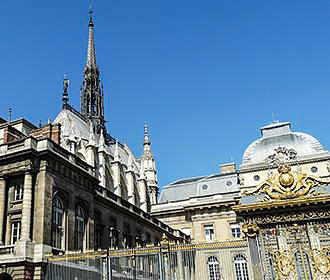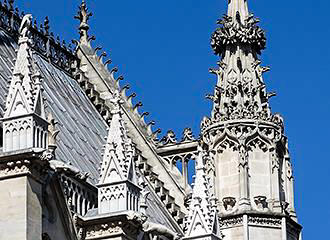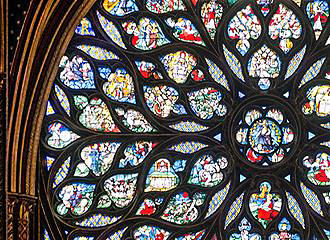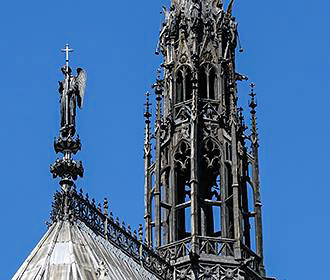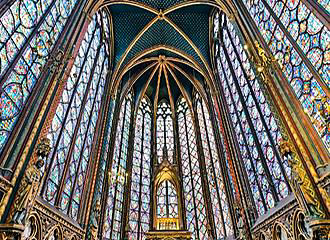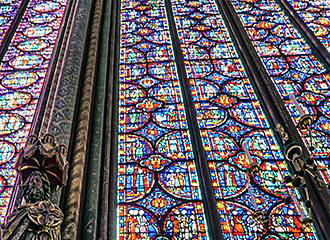Paris Sainte Chapelle at La Conciergerie
Located on the Ile de la Cite, which is an island in the middle of the River Seine, the Sainte Chapelle is a small chapel that has become one of the renowned historical Paris monuments and a museum with some very unique features that makes it an ideal place to visit whilst on holiday in Paris.
History of Sainte Chapelle
It was King Louis IX who wanted a chapel built that he could go to for worship but be only a short walk from his palace, and also for somewhere he could keep his relics, so the original plans of the chapel date back to the year 1241, which were mainly attributed to Pierre de Montreuil, who had completed the south facade of the Notre Dame Cathedral.
The specific site was eventually chosen on the Ile de la Cite, which was close to the Notre Dame Cathedral and also to La Conciergerie, which is the oldest remaining part of the first palace for the Kings of France. And construction on the Sainte Chapelle started in 1246, yet incredibly, the whole chapel was completed by 1248 and consecrated on 26th April that very same year.
When the construction was completed the Sainte Chapelle was and still is a masterpiece of flamboyant Gothic architecture and there were actually two sanctuaries that were built on top of each other and just like many church walls that were decorated in the Middle Ages, the lower chapel was decorated with an Annunciation, which today is the oldest wall painting in Paris.
However, the upper chapel is where you can really get to see the beauty of this place with its vaulted ceiling and this floor was reserved for King Louis and his court along with his religious relics he had collected.
In fact, King Louis was very different from many devout aristocrats that regularly swiped relics, he would paid large amounts of money for some, such as the Crown of Thorns and a part of the True Cross that were purchased from the impoverished Emporor Baldwin II in Constantinople. And apparently, these relics alone cost over three times what it cost to build the chapel!
When visiting the Chapelle you will be able to see the 15 fabulous stained glass windows in the upper chapel that depict 1,113 scenes from the Old Testament and the Passion of Christ and two thirds of these are original from when the Sainte Chapelle was first built, which is rather a miracle in itself, as many places were destroyed through the French Revolution.
However, because the chapel was converted into an administrative office, a lot of the stained glass windows were covered by cabinets and therefore they were protected from vandalism during the French Revolution, even though some other aspects of the chapel, such as the choir stalls and the spire were demolished.
Unfortunately most of the relics that King Louis had acquired were also removed or destroyed, but the remaining ones are now held in the treasury of Notre Dame.
As on the inside of the Sainte Chapelle, on the outside you can also see the unique stained glass windows which radiate different lights and colours and today there is another spire in place.
It was back in the 19th century that the Sainte Chapelle was restored by Eugene-Emmannuel Viollet-le-Duc who was a Gothic revival architect and restorer of French medieval buildings, along with Jean-Bapiste Lassus, who was also an architect and historian.
They focused on the interior, but also the spire that had been brought down in the French Revolution and the design of the spire by Eugene-Emmanuel Viollet-le-Duc was a replica of the 15th century spire that is over 30m high and made of cedar.
Visiting the Sainte Chapelle in Paris
You can get to the Ile de la Cite in a variety of different ways, and due to its location you can get to see some of the other famous landmarks and monuments in Paris like the Conciergerie and Notre Dame Cathedral, as these are only a short walk from the Sainte Chapelle itself.
You can reach this spectacular landmark in Paris via the Metro station Cite on line 4 or by Paris bus on lines 21, 27, 38, 85 and 96. The Batobus, that runs just like a bus service, but on water up and down the River Seine, which is also another way you can get to the Sainte Chapelle whilst you are on holiday in Paris.
The chapel is open every day of the year except for 1st January, 1st May and the 25th December and on other National French holidays, but we would like to point out that access to this chapel is controlled by the Gendarmerie, which is French police. And it is therefore strictly forbidden for any visitor to be in possession of any metal objects such as knives, scissors and any other sharp metal instrument.
From the start of March through to the end of October the Sainte Chapelle is open from 9.30am through to 6pm and from the start of November through to the end of February it opens from 9am to 5pm.
However from mid May through to mid September the chapel is also open later on a Wednesday evening right up until 9pm although the last entry is always 30 minutes before closing time.
Unaccompanied visits are available with a guide booklet available in different languages, which are French, English, German, Spanish, Italian and Japanese, but there are also guided visits available in French, English and Spanish along with lectures and group visits that are all available upon reservation.
As of 2012 the cost for entry is €8.50 but people under the age of 18 who are accompanied by an adult have free admission, yet there is also a reduced rate available for the disabled and the person accompanying them.
However, if you wish to experience more on the Ile de la Cite island in the River Seine, then you could also visit The Conciergerie, which is located adjacent to the Sainte Chapelle and is the oldest prison in France where Marie-Antoinette was detained. So if you choose to do this, then you can purchase a combined ticket and as of 2012, this is a cost of €12.50.
